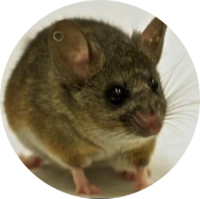Neuroendocrine mechanisms of social vigilance

We study the underlying neural mechanisms of social behaviors that are related to mental illness from a naturalistic perspective. A new focus in the lab is a behavior referred to as social vigilance. Social vigilance occurs when a mouse avoids an unfamiliar individual but simultaneously orients towards this individual. This behavior is interesting because a combination of avoidance and vigilance, referred to as behavioral inhibition, is a common behavioral pattern seen in anxiety disorders. Indeed, behavioral inhibition is a major risk factor for the development of anxiety disorders. A major focus for the lab is the bed nucleus of the stria terminalis, which controls social vigilance in mice and has been implicated in anxiety disorders in humans. We study monogamous California mice to investigate how social stress impacts neural circuits of social vigilance in males and females. We are also beginning to study how adolescent development impacts this circuitry. The longer lifespan of California mice is characterized by a comparatively extended period of adolescent development compared to conventional laboratory rodent species.
Key Publications
Wright, E. C., Luo, P. X., Zakharenkov, H. C., Serna Godoy, A., Lake, A., A., Prince, Z. D., Sekar, S., Culkin, H. I., Ramirez, A. V., Dwyer, T., Kapor, A., Corbett, C., Tian, L., Fox, A. S., Trainor, B. C. 2023. Sexual differentiation of neural mechanisms of stress sensitivity during puberty. Proceedings of the National Academy of Sciences U.S.A., 120, e2306475120.
Williams, A. V., Peña, C. J., Ramos-Maciel, S., Laman-Maharg, A., Ordoñez-Sanches, E., M., Britton, Durbin-Johnson, B., Settles, M., Hao, R., Yokoyama, S., Xu, C., Luo, P. X., Dwyer, T., Bhela, S., Black, A. M., Labonté, B., Serafini, R. A., Ruiz, A., Neve, R. L., Zachariou, V., Nestler, E. J., Trainor, B. C. 2022. Comparative transcriptional analyses in the nucleus accumbens identifies RGS2 as a key mediator of depression-related behavior. Biological Psychiatry, in press.
Duque-Wilckens, N., Torres, L. Y., Yokoyama, S., Minie, V., Tran, A. M., Petkova, S. P., Hao, R., Ramos-Maciel, S. Rios, R. A., Jackson, K., Flores-Ramirez, F. J., Garcia-Carachure, I., Pesavento, P. A., Iñiguez, S. A., Grinevich, V. J. & Trainor, B. C. 2020. Extra-hypothalamic oxytocin neurons drive stress-induced social vigilance and avoidance. Proceedings of the National Academy of Sciences U.S.A.
Steinman, M. Q., Duque-Wilckens, N & Trainor, B. C. 2019. Complementary neural circuits for divergent effects of oxytocin: social approach versus social anxiety. Biological Psychiatry. 85, 792-801.
Williams, A. V., Duque-Wilckens, N. Ramos-Maciel, S., Campi, K. L., Bhela, S., Xu, C. K. Jackson, K., Chini, B. Pesavento, P. A. & Trainor, B. C. 2020. Social approach and social vigilance are differentially regulated by oxytocin receptors in the nucleus accumbens. Neuropsychopharmacology.
Duque-Wilckens, N., Steinman, M. Q., Busnelli, M, Chini, B., Yokoyama, S., Pham, M., Laredo, S. A.,R. Hao, Perkeybile, A. M., Minie, V. A., Tan, P. B.. Bales, K. L. and Trainor, B. C. 2018. Oxytocin receptors in the anteromedial bed nucleus of the stria terminalis promote stress-induced social avoidance in females. Biological Psychiatry, 80, 203-213.
Updated March 2024